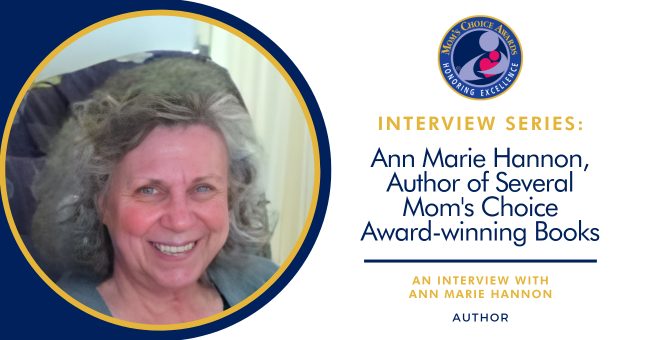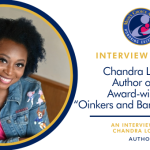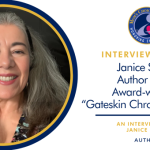Mom’s Choice Awards is excited to announce another post in our interview series where we chat with the inventors, designers, publishers, and others behind some of our favorite family-friendly products.
We’re excited to welcome Ann Marie Hannon, a talented author whose books have earned multiple Mom’s Choice Awards. Ann Marie’s stories, including Puffy and the Formidable Foe and All About A Boy Who Was Afraid of the Dark, teach valuable lessons about problem-solving, empathy, and collaboration. With a background in mediation, her writing encourages children to navigate challenges with understanding and teamwork. Today, Ann Marie shares her journey, inspiration, and the impact her books have on young readers and their families.
Can you tell us a bit about yourself?
I’ve always had a love for writing and reading, starting at a young age. I remember being 11 years old, working on a homework assignment that required writing a poem, which my mom helped me with. From then on, I started writing in a diary and reading every chance I could. Even before school gave homework, I was borrowing books from the local library and reading constantly. This love for literature grew over the years, and by college, I was contributing articles to the college newspaper. Later, I earned a graduate degree and received commendation for my thesis. But the most pivotal moment in my life was when I decided to learn to listen more—leading me to mediation training. This training deeply influenced my relationships, spirituality, writing, and outlook on life.
What inspired you to become a writer?
Reading the works of others has always inspired me. I realized that through writing, I could share my thoughts, values, and beliefs with others. I encouraged myself to pursue writing by taking courses over the years, one of the most influential being with Sheila Bender, a writing instructor on the West Coast. After taking one of her online courses, I shared the original draft of my book All About A Boy Who Was Afraid of the Dark with her. Sheila encouraged me to add illustrations, which led me to revise and expand the story, ultimately preserving its central theme about overcoming fear through the help of family.
Can you tell us about the inspiration behind your books, like Puffy and the Formidable Foe, All About A Boy Who Was Afraid of the Dark, and A Going Home Surprise?
Each book was inspired by different experiences. Puffy was inspired by a poem my mom sent me about the dangers of going outside alone. All About A Boy Who Was Afraid of the Dark drew from my mediation training, showing how communication can help resolve problems. A Going Home Surprise was inspired by my own experiences with our youngest child and the importance of family bonds.
You’ve mentioned before that your stories have happy endings with important messages for both parents and children. What messages can we find in your award-winning books like Puffy and the Formidable Foe, All About A Boy Who Was Afraid of the Dark, and A Going Home Surprise?
The messages in my stories include the importance of not jumping to conclusions, understanding that decisions come with responsibilities and benefits, and taking ownership of one’s choices to make them positive. These lessons are conveyed through the experiences of children learning and growing through challenges.
What kind of response have you received from readers?
I’ve received many positive reviews, which have helped improve my books. The best feedback I’ve received is that my books would be valuable in classroom and library settings, which I consider the greatest compliment.
How has your mediation training influenced your writing, especially in terms of problem-solving and collaboration?
My mediation training taught me the importance of neutrality and problem-solving. I incorporate this into my books by making them interactive, encouraging parents to ask children about the story and what they would do in similar situations. This helps children understand the lessons about resolving conflicts and working together.
Have you found that some children struggle with the problem-solving skills you teach in your stories?
That’s why my books are designed to be interactive—parents aren’t just reading the story, but also engaging with their children by asking questions that help them process the story’s message. This interaction ensures children grasp the problem-solving lessons more effectively.
If you could ensure readers of your books take away one lesson, what would it be?
I hope parents will believe in their children, as this belief can inspire children to believe in their parents. We all have doubts and worries, but my books are meant to show how we can solve problems and overcome challenges.
Keep reading to find an excerpt from a recent podcast interview with Ann Marie Hannon!
…So, let me cut to the chase and explain that, of course, I will get to “me and my books” if we have time. But first, I would like to start with this: what to learn about writing and creativity in 15 steps or less. I say “15 steps or less” because your listeners, who may be writers, may have already arrived at some or many of these!
So, here goes. What I’m about to share is in a sort of chronology of learning for me, but it doesn’t have to be that way for you. Here are 15 steps (or less) to writing for real:
- Accept that creativity has many side roads and detours, and it won’t always turn out the way you want.
- It’s important to seek mentorship.
- Take time to step aside from your “magnum opus.”
- Never hesitate to edit, re-edit, add, delete, polish, etc.
- Reach out to others (authors, readers of your books—kids who read my books, in my case—and members of author/writing organizations).
- Use ChatGPT wisely.
- Don’t dissuade yourself from writing a novel, since each time you try, you will become better at it.
- Have others “beta test” your work before final publication.
- Seek literary agent representation as time permits.
- Learn, learn, learn from negative as well as positive feedback.
- Consider donating your books to libraries and other free book organizations. “Word of mouth” can do a lot.
- Be as frugal as possible with spending and stick to a budget.
- Be aware of “scammers” and “frauds.”
- Consider spending funds on simply repurposing a new book cover.
- “Take time to smell the roses.” What I mean by that is, use your personal time for things outside of writing. You deserve that, too.
Now, for a little bit about me and more about my books, starting with The Power of a Flower, a Gold Award book from Mom’s Choice Awards and a prestigious Seal of Excellence in Family Friend Media. I view it as a great achievement in my writing life.
Oops, two more steps to writing for real… #16 is Carpe Diem. That literally means “seize the day” in Latin (I had 4 years of Latin in high school, and it still helps with vocabulary), and what it means more appropriately is “take the opportunity.” For me, that means, if I get an idea for a story, a quote, or anything related, I make sure to jot it down right away in case it becomes useful later. Next… #17 is Don’t throw away anything. For me, at least, this means years ago I saved a small storyboard my older daughter created to show what happens to a seed when she was probably in 3rd grade. Well, when clearing out clutter about a year ago, I found that storyboard and it intrigued and inspired me so much that it caused me to write The Power of a Flower, my Gold Mom’s Choice Award-winning book.
So, about The Power of a Flower: It is a short but powerful story that offers hope and understanding for moments when sadness or a sense of abandonment overwhelm. The book achieves this theme through a gift that a little girl finds, which renews the circle of life.
This story also promotes the importance of genuine and enduring friendships through shared memories.
The Power of a Flower is a prequel to my other award-winning books, although it was written at almost the end of my other books in the Kids with Worries series.
I use problem-solving to aid kids in their growth and learning. The storytelling is easy to understand, and the solutions resonate with kids and parents.
I also want to say that I honor anyone who wants to write and uses writing to express creative thinking in an imaginative way.
I also recognize that it is a different experience for every writer, and not every writer follows the same path.
My background training and experience pushed me to work at writing in a way that is likely very different from others, or even the norm.
But that’s not the issue so much as the fact that I love to write, whether it’s a policy document, a research paper, a text to my kids, or a children’s picture book.
I also like to take a moment to make sure that what I’ve written is on point, and if it needs a rewrite or edit, I do that too.
I come from what I like to call the Ann Marie School of Writing, and Lesson 1 is to believe that even though it has to be final for the publisher, it can always still be better.
So, now more recently, I’ve become actively engaged in TV pilot screenplay writing.
The pilot is called Dear Grandma Annie, and the pilot episode revolves around two youngsters—two sisters, but it could be a brother and a sister or two friends who have a rivalry going on.
In this case, the two sisters have sibling rivalry, but they reach out to Grandma Annie and her stories for help. Her stories allow the characters to develop skills that diminish their sibling rivalry and help them to overcome their competitiveness against each other.
With Grandma Annie’s help, they instead learn to work together and establish a team approach that uses creativity and problem-solving for everyday worries and happenings.
You can learn more about Ann Marie Hannon and her award-winning books by visiting her MCA Shop page.
Other Posts You Might Like





